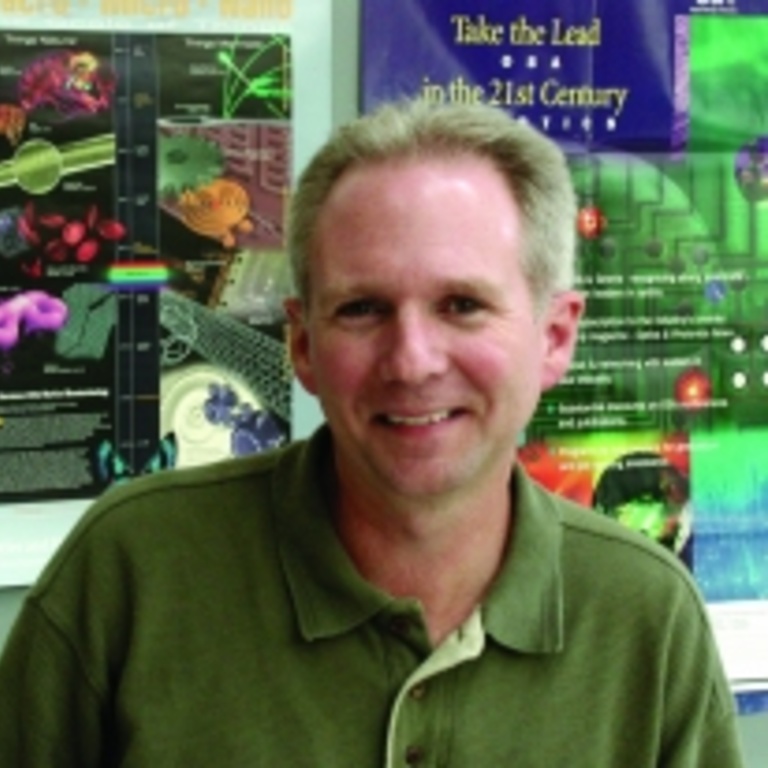Mark A. Arnold
Keywords
- Chemical sensors
- Near infrared spectroscopy
- Noninvasive analytical sensing
- Noninvasive blood glucose sensing
- Reagent-based optical sensors
- Biosensing probes
- Chemometrics
Research interests
Chemical sensing technology is being developed for applications in biomedical research, clinical chemistry, neuroscience, bioprocess monitoring, biotechnology, and environmental sciences. Spectroscopic and optical methods are used to measure selected chemical analytes in complex matrices. Examples include noninvasive blood glucose sensing in people with diabetes , on-line systemic urea monitoring during hemodialysis treatments, real-time monitoring of cellular nutrients and metabolites in functioning bioreactors, and remote, continuous dissolved oxygen measurements in biological systems.
Near infrared spectroscopy is being developed to measure blood glucose levels in human subjects both painlessly and noninvasively. The concept is to pass a harmless band of near infrared light through the human body and then extract the glucose concentration information from the transmitted spectral radiation. Digital filtering techniques and multivariate calibration methods, such as partial least-squares regression, are used to extract glucose information accurately from noninvasive near infrared spectra collected from complex biological matrices. We have developed an in vitro model of the human body to help identify and characterize experimental parameters that are critical for noninvasive blood glucose measurements. Investigated parameters include scattering, spectrometer signal-to-noise ratios, optical path length and spectral correlations within a data set. Complications of spectral correlations can be considerable when sample glucose levels correlate with other chemical species within the sample matrix. More importantly, temporal correlations can greatly impact analytical performance. Experimental design methods must be applied to avoid bogus calibration models created by such correlations. In addition to blood glucose, we are presently exploring the application of near infrared spectroscopy for measuring:
- systemic urea during hemodialysis treatments,
- glucose, lactate, ammonia, and glutamine during cultivation of mammalian and insect cells,
- dissolved protein during crystallization, and
- methanol levels used to induce microbial recombinant processes.
Many sensor applications demand continuous operation over extended periods without user intervention. The measurement of dissolved oxygen in growth media during bioreactor operation on-board the Space Shuttle is one such application. Sensor recalibration is not possible after the shuttle is launched, which means measurement accuracy requires stable calibrations. Stable chemical sensors are being developed for remote sensing by using radioluminescent (RL) light sources. Our RL sources are composed of tritium gas coupled with an inorganic phosphor. Beta emission from the tritium excites a phosphor and the excited phosphor subsequently relaxes to produces a photon. RL-optical sensors for dissolved oxygen are being developed on the basis of dynamic fluorescence quenching of immobilized ruthenium complexes. Low noise and high stability of RL sources provide low detection limits and long term stability.
Kromoscopy is a new measurement code for analytical science. In this method, white light passes through the sample and the transmitted light is divided into four separate detector channels. The response function of each channel is defined by the source, detector, and bandpass function of a filter that is position immediately before the detector. Each chemical species displays a unique Kromoscopic response when represented as a vector in the multidimensional space defined by the four detector signals. Tremendously high signal-to-noise ratios are possible with this instrument configuration. We are presently characterizing the selectivity of Kromoscopy by defining conditions under which glucose can be measured at clinically relevant concentrations in the presence of common, endogenous interferences, such as urea, triglycerides, hemoglobin, cholesterol, and protein.
Recent publications
Bohman, A; Arnold, MA; Molar absorptivity measurements in absorbing solvents: Impact on solvent absorptivity values; Applied Spectroscopy 2016, 70:DOI: https://doi.org/10.1177/0003702816662883.
2.Parker, SA; Maloy, MH; Tome-Amat, J; Bardliving, CL; Batt, CA; Lanz, KJ; Olesberg, JT; Arnold, MA; Optimization of norovirus virus-like particle production in Pichia Pastoris using a real-time near-infrared bioprocess monitor; Biotechnology Progress 2016 32:518-526.
3.Smith, RM; Arnold, MA; Selectivity of terahertz spectroscopy for gaseous analytes; Analytical Chemistry 2015 87:10679-10683.
4.Rupasinghe, TP; Hutchins, KM; Bandaranayake, BS; Ghorai, S; Karunatilake, C; Bučar, D-K; Swenson, DC; Arnold, MA; MacGillivray, LR; Tivanski, AV; Mechanical properties of a series of macro- and nano-dimensional organic cocrystals correlate with atomic polarizability; Journal of the American Chemical Society 2015 137: 12768-12771.
5.Kim, S; d’Anjou, M; Lanz, KJ; Evans, CE; Gibso, ER; Olesberg, JT; Mallen, M; Shandil, I; Nylen, A; Koerperick, EJ; Cooley, DW; Brower, GA; Small, GW; Arnold, MA; Real-time monitoring of glycerol and methanol to enhance antibody production in industrial Pichia pastoris bioprocesses; Biochemical Engineering Journal; 2015 94:115-124.
6.Goldfeld, M; Christensen, J; Pollard, D; Gibson, ER; Olesberg, JT; Koerperick, EJ; Lanz, K; Small, GW; Arnold, MA; Evans, CE; Advanced near-infrared monitor for stable real-time measurement and control of Pichia pastoris bioprocesses; Biotechnology Progress; 2014 30:749-759.
7.Qiu, J; Arnold, MA; Murhammer, DW; On-line near infrared bioreactor monitoring of cell density and concentrations of glucose and lactate during insect cell cultivation; Journal of Biotechnology 2014, 173, 106-111.
8.Namkung, H; Kim, J; Lee, S; Chung, H; Arnold, MA; Impact of pellet thickness on quantitative terahertz spectroscopy of solid samples in a polyethylene matrix; Analytical Chemistry, 2013, 85:3674-3681.
9.Xiang, D; Arnold, MA; Chemical imaging with a solid-state near infrared spectrometer based on a digital micro-mirror array device coupled with Hadamard transform spectroscopy; Analytical Letters 2012, 47:1070-1078.
10.Smith, RM; Arnold, MA; Terahertz time-domain spectroscopy of solid samples: Principles, applications, and challenges; Applied Spectroscopy Review 2011, 46 636-679.
- Analytical chemistry
